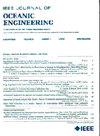Laser-Acoustic Cross-Medium Communication (LACMC) System: Theoretical Channel Model and Experiments
IF 3.8
2区 工程技术
Q1 ENGINEERING, CIVIL
引用次数: 0
Abstract
Recent advancements in acoustic and millimeter-wave technologies have enabled direct communication over water–air interfaces. This cross-medium communication involves three key steps: an underwater transducer emits acoustic waves that create surface vibrations, airborne radars detect these vibrations using millimeter waves, and finally, processed radar signals facilitate communication. However, this scheme suffers from short communication distances (approximately 1 m over water) and low resolution (millimetre level). In this article, a laser-acoustic cross-medium communication (LACMC) system is proposed and validated in anechoic tank experiments with the expectation of addressing the challenges of direct, high-precision, long-range communication across water--air interfaces for integrated air--sea networking. We analyze signal transmission through underwater, water surface, and air mediums and establish a robust LACMC channel model, which was verified by experiments. Experimental results prove that the channel is time-invariant and frequency-selective, with a single direct path and no multipath effects. We further enhance cross-medium communication quality by designing appropriate transmitted signals based on channel characteristics and employing laser Doppler vibrometry for high-precision, noncontact measurements. Our experimental results demonstrate the system's efficacy in long-distance applications, achieving an underwater communication distance of 3.5 m and an above-water distance of 10.8 m. The study is expected to provide a foundation for direct, high-precision, and long-distance communication between underwater nodes and airborne nodes.激光声跨介质通信(LACMC)系统:理论信道模型与实验
声学和毫米波技术的最新进展使水-空气接口上的直接通信成为可能。这种跨媒介通信包括三个关键步骤:水下换能器发出声波,产生表面振动,机载雷达使用毫米波探测这些振动,最后,处理后的雷达信号促进通信。然而,这种方案的缺点是通信距离短(在水面上大约1米)和分辨率低(毫米级)。在本文中,提出了一种激光声学跨介质通信(LACMC)系统,并在消声槽实验中进行了验证,以期解决集成空-海网络中直接,高精度,跨水-空接口远程通信的挑战。我们分析了信号在水下、水面和空气介质中的传输,建立了一个鲁棒的LACMC信道模型,并通过实验进行了验证。实验结果表明,该信道具有时不变和频率选择性,具有单一直接路径,无多径效应。我们根据信道特性设计合适的传输信号,并采用激光多普勒振动仪进行高精度、非接触测量,进一步提高了跨介质通信质量。实验结果证明了该系统在远距离应用中的有效性,实现了3.5 m的水下通信距离和10.8 m的水上通信距离。该研究有望为水下节点与机载节点之间的直接、高精度、远距离通信提供基础。
本文章由计算机程序翻译,如有差异,请以英文原文为准。
求助全文
约1分钟内获得全文
求助全文
来源期刊

IEEE Journal of Oceanic Engineering
工程技术-工程:大洋
CiteScore
9.60
自引率
12.20%
发文量
86
审稿时长
12 months
期刊介绍:
The IEEE Journal of Oceanic Engineering (ISSN 0364-9059) is the online-only quarterly publication of the IEEE Oceanic Engineering Society (IEEE OES). The scope of the Journal is the field of interest of the IEEE OES, which encompasses all aspects of science, engineering, and technology that address research, development, and operations pertaining to all bodies of water. This includes the creation of new capabilities and technologies from concept design through prototypes, testing, and operational systems to sense, explore, understand, develop, use, and responsibly manage natural resources.
 求助内容:
求助内容: 应助结果提醒方式:
应助结果提醒方式:


